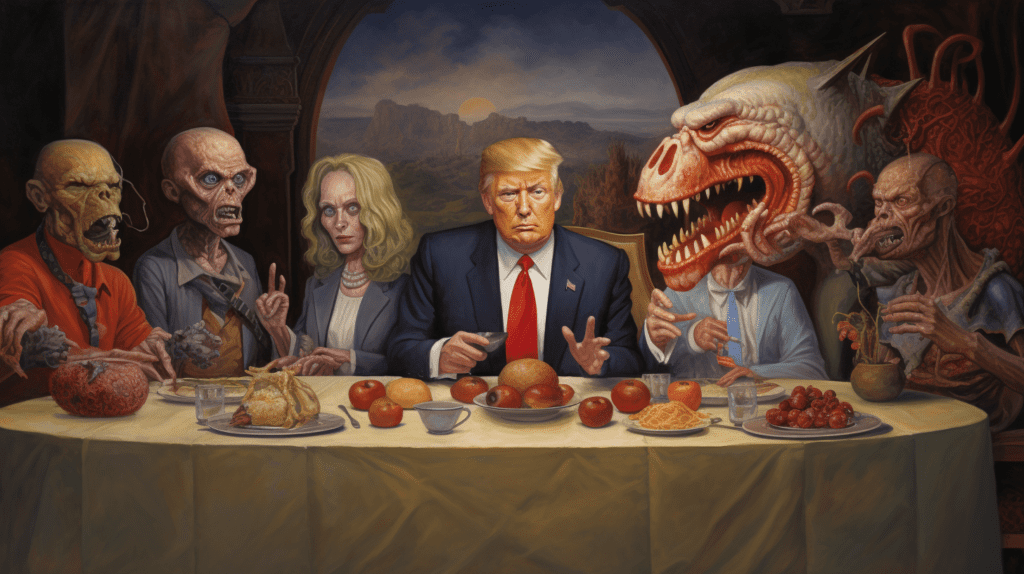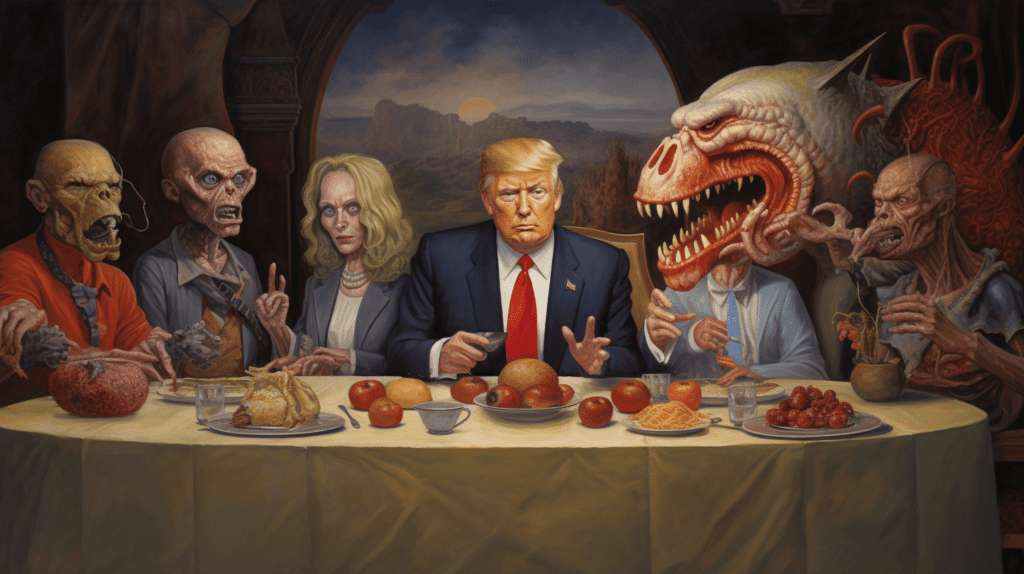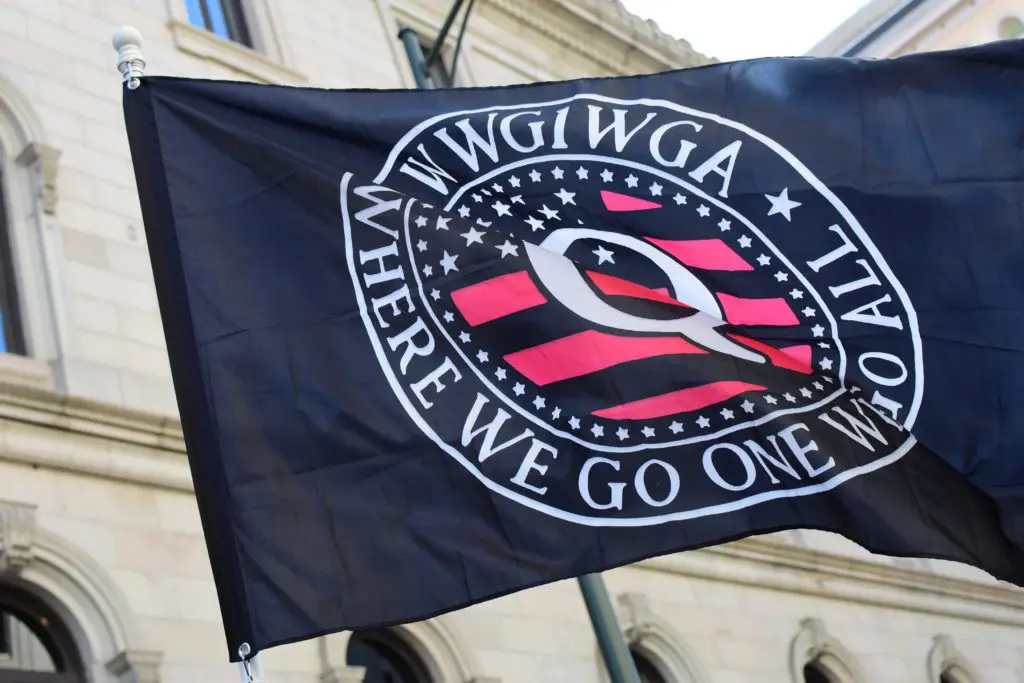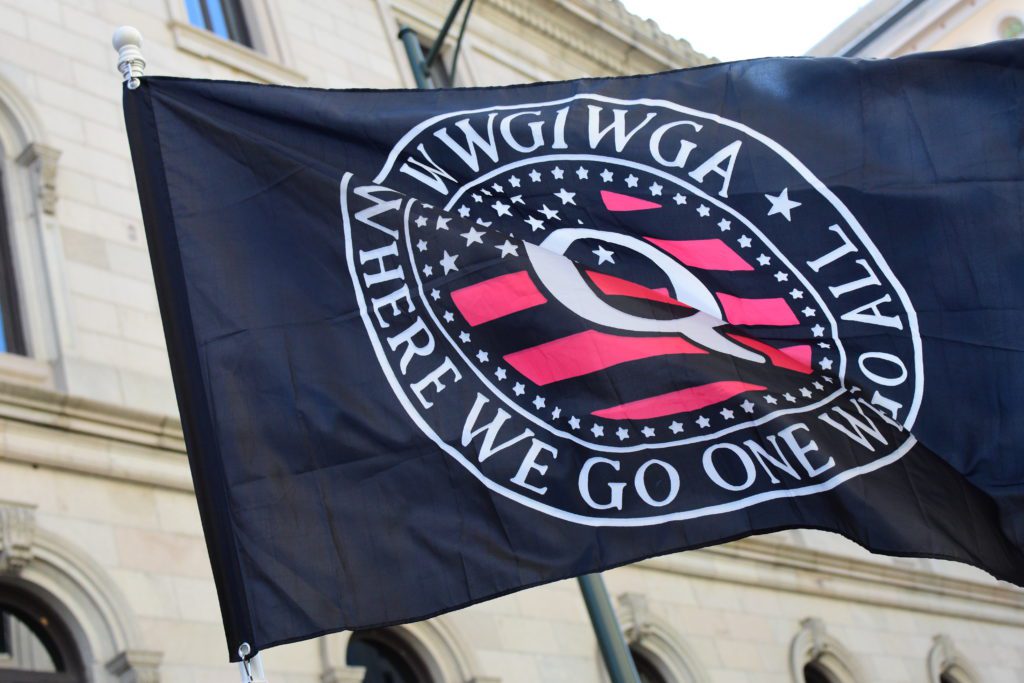We glibly believed it could never happen here even though we’ve been warned again and again. And in some sense, even though it’s been here all along — hiding in plain sight. It could happen here, and it did, because it’s happened here before. This dictionary of American authoritarianism collects definitions and charts the rise of language, ideology, tactics, and historical movements of American authoritarians, to arm us with the knowledge we need to understand the tricks of the trade.
For a long time it was convenient to think of authoritarian personality as primarily a European problem, or in any case, a phenomenon that happened elsewhere. We are still waking up (…again) to the scope and depth of the problem, while anti-government groups organize relatively openly and we have yet to see justice for the January 6 attack on our capital. There is much work to be done, and in the meantime we can always continue to educate ourselves about our nation’s history — and the role of slavery, white nationalism, and racism in the shaping of the country and the future class structure of today’s America.
The myth of white innocence is toxic to this understanding. Those who say they “don’t see” race or “don’t want to talk about” race put their white privilege on full display in demanding their right to opt-out of the discussion on race. They’re not interested in having a discussion on race — they’re interested in silencing events like the Tulsa Race Massacre and ensuring we lack the language even to describe the horrors being visited upon human beings by the silencers. The only “discussion” they want to have about the matter is spoken in the words of Smith & Wesson, Chapter AR-15.
American Authoritarianism
White supremacy, in fact, in part inspired Adolf Hitler and the Nazis. In turn, the Nazis inspired the original America First movement at the hands of Charles Lindbergh, a notoriously avowed anti-Semite who vociferously opposed America’s involvement in World War II. Lindbergh and the other early movement conservative extremists lost the battle, and the Allies won the war — thus, fascism as an ideology was defeated in the popular mind for a goodly while.
But prejudice and bigotry are beasts that never sleep — only fitfully slumber and simmer beneath the surface. Bigotry has been rebuilding covertly for years and decades, if it can even be said to have gone away. America has always had its strain of autocratic fascination — and that strain of authoritarianism began flirting with what became fascism in the 20th century. The extremists yearning for a consummation of American fascism have continued to work diligently for almost a century, and have now largely succeeded in injecting a virulent form of nationalism, xenophobia, and isolationism into mainstream GOP politics in the 21st century.
The election of Donald Trump in 2016 seemed to unleash these latent forces that have been amassing since the Reagan years, growing more virulent during the 1990s. From Pat Buchanan and Newt Gingrich of yesteryear to Marjorie Taylor Greene and Ron DeSantis today, the American right-wing is more and more overtly appealing to anti-democratic methods and ideologies — and no longer seem to be regarded as the kooks and cranks of the Republican Party as their equivalents were during the John Birch Society era.
Authoritarianism Dictionary
I’ll be adding to this authoritarianism dictionary over time, as I can chip away at it and as new words get added to the lexicon. It’s highly encouraging that the American people were able to throw off the would-be dictator Trump, but the Republican party continues to press their seditious aims in his name. They continue to trade on the Confederate ideals long defeated, discredited, and dishonored in this nation. Let’s educate each other on the techniques being used against us by the powerful to limit our frames, and to inhibit our awareness, our choices, and our awareness of our choices.
The hour is late, and we must act with all haste.
| Term | Topic | Definition |
|---|---|---|
| 1st Amendment | government | "Congress shall make no law respecting an establishment of religion, or prohibiting the free exercise thereof; or abridging the freedom of speech, or of the press; or the right of the people peaceably to assemble, and to petition the government for a redress of grievances." |
| 2nd Amendment | government | "A well regulated militia, being necessary to the security of a free state, the right of the people to keep and bear arms, shall not be infringed." |
| 13th Amendment | white supremacy | The Amendment that put an end to slavery. It was passed by Congress and ratified by 2/3 of the states in 1865. |
| 14th Amendment | white supremacy | The second Constitutional Amendment passed following the Civil War, the Fourteenth Amendment granted citizenship to freed African American former slaves, along with equal civil and legal rights as specified in the Constitution. |
| 15th Amendment | white supremacy | Third and last of the Reconstruction Amendments, the Fifteenth gave African Americans the right to vote -- and prohibited any type of voter discrimination on the basis of race. |
| 19th Amendment | misogyny | The woman's Suffrage Amendment gave women the right to vote in the United States. |
| 4chan | alt-Right | A notorious internet message board with an unruly culture capable of trolling, pranks, and crimes. |
| 4GW | Fourth-generation warfare, a model of hybrid warfare proposed by William S. Lind (of "cultural Marxism" fame) | |
| 8chan | alt-Right | If 4chan wasn't raw and lawless enough for you, you could try the even more right-wing "free speech"-haven 8chan while it still stood (now 8kun). Described by its founder Frederick Bennan as "if 4chan and reddit had a baby," the site is notorious for incubating Gamergate, which morphed into PizzaGate, which morphed into QAnon -- and for generally being a cesspool of humanity's worst stuff. |
| 8kun | alt-Right | The rebranded incarnation of 8chan after being booted offline and haggling with its founder, Frederick Brennan. |
| abortion | religious extremism | The safe medical procedure for ending a pregnancy. |
| active measures | Russian | A style of political warfare originating in the Soviet Union in the 1920s incorporating spycraft, disinformation, propaganda, sabotage, and destabilization, among other offensive programs targeting the USSR's geopolitical foes including the United States. |
| ad populum | Rhetorical fallacy that assumes an opinion shared by the majority is correct -- without consideration of the credentials of the group. | |
| aggrieved entitlement | white supremacy | A term coined by sociologist Michael Kimmel, who documents the perceived emasculation of America's white male uneducated class and their reactionary rage against social justice and marginal groups getting the spotlight. |
| America's "original sin" | white supremacy | A reference to the institution of slavery. |
| amoral | abuse & control | Without morality; without empathy or compassion. |
| anti-abortion | religious extremism | Political movement formed in the 1970s to overturn Roe v. Wade, that has become a major pillar of the Republican Party |
| anti-Communist | conspiracy theory | The Cold War Red Scare was promulgated by Senator Eugene McCarthy with help from lawyer Roy Cohn -- who later famously weaned Donald Trump in his image. The John Birch Society and movement conservatives seethed about ehe enemies within, as middle America set about booming with the Boomers for an entire generation of widely shared prosperity. |
| anti-intraception | psychological warfare | Psychologist Theodor Adorno's term for individuals who resist self-reflection and exhibit the absence of looking inward. |
| anti-racism | A proactive stance against racial prejudice and systemic discrimination, advocating for policies and practices that promote racial equity and justice. | |
| anti-Semitism | Hostility, prejudice, or discrimination against Jewish people, manifesting in social, economic, and political exclusion or violence. | |
| anti-tax | plutocracy | A political position opposing taxation, often advocating for reduced government spending and intervention in economic affairs. |
| armed robbery | organized crime | The act of stealing from a person or place using weapons or the threat of violence, constituting a serious criminal offense. |
| aryan | Historically misappropriated by Nazi ideology to denote a supposed "master race," originally referring to Indo-Iranian language speakers. | |
| Ashe experiments | psychological warfare | A series of 1950s social psychology studies by Solomon Asch demonstrating the influence of group pressure on individual conformity. |
| ASPD | abuse & control | A mental health condition characterized by a pervasive disregard for others' rights, often leading to deceitful, manipulative, or criminal behavior. |
| assassination | paramilitary | The killing of a head of state or other important figure for political or ideological reasons, as opposed to murder as a crime of passion. |
| astroturfing | psychological warfare | The deceptive practice of creating the illusion of grassroots support for a cause or organization, often orchestrated by vested interests. |
| authoritarianism | government | A governance system where power is concentrated in a single authority, limiting political freedoms and often suppressing dissent. |
| banality of evil | Hannah Arendt coined the phrase “banality of evil” to refer to the confoundingly commonplace motives of the Nazis who perpetrated some of the worst war crimes in history -- they would never have struck anyone as potential mass murderers before the war. | |
| banana republic | plutocracy | politically unstable countries whose economies are monocultures controlled by an oligarchy; puppet states |
| bandwagon | The phenomenon where individuals adopt beliefs or behaviors because others do, often leading to a majority opinion or trend. | |
| Biblical inerrancy | The doctrine asserting that the Bible, in its original manuscripts, is without error in all its teachings, encompassing theology, history, and science | |
| The Big Lie | A propaganda technique involving the repetition of a colossal falsehood to make it accepted as truth; notably used by Adolf Hitler to describe the deceit he attributed to his enemies. | |
| birth control | misogyny | Methods or devices used to prevent pregnancy, enabling individuals to plan if and when to have children. |
| birtherism | Conspiracy theory started by Donald Trump claiming that Barack Obama wasn't born in the U.S. and thus, ineligible for the presidency | |
| bitcoin | alt-Right | A decentralized digital currency operating without a central authority, utilizing blockchain technology for secure transactions. |
| Black Codes | white supremacy | Laws enacted in the post-Civil War Southern United States aiming to restrict African Americans' freedom and compel them to work in a labor economy based on low wages or debt. |
| black-pilled | A term denoting a pessimistic worldview, often associated with the belief that societal decline is inevitable and irreversible. | |
| BLM | white supremacy | A decentralized social and political movement that began in 2013, aiming to address systemic racism and violence against Black individuals, particularly focusing on issues like police brutality and racial inequality |
| BLM (Bureau of Land Management) | government | An agency within the U.S. Department of the Interior, established in 1946, responsible for administering public lands, primarily in the western United States, overseeing activities such as energy development, livestock grazing, and recreation. |
| blockchain | alt-Right | Digital ledger of events and transactions that powers cryptocurrencies like Bitcoin. |
| blood libel | conspiracy theory | A false and anti-Semitic accusation alleging that Jewish people use the blood of Christians, particularly children, in religious rituals. |
| Blue Checks | psychological warfare | Reference to Twitter's "verified" feature for certain members, who have satisfied the company that they are who they say they are. Originally the feature was meant to identify the official accounts of news sites and reporters, so it has both an association with -- and a legitimate lineage from -- the media industry. |
| bolt hole | End Times | A type of retreat or refuge for those in the survivalist subculture, to be absconded to in case of disaster or apocalypse (see also: bug-out location). |
| Brooks Brothers Riot | Sedition Caucus | A coordinated protest by Republican operatives led by notorious dirty trickster Roger Stone on November 22, 2000, aimed at halting the vote recount in Miami-Dade County during the U.S. presidential election, effectively influencing the election outcome |
| Brown v. Board of Education (1954) | white supremacy | Supreme Court decision ordering the desegregation of schools. Resistance to the ruling took the form of "states' rights" advocates, among much else. |
| bugman | A derogatory term used by some in the New Right to describe liberal men perceived as lacking traditional masculinity and practical life skills. | |
| bug-out location (BOL) | End Times | A predetermined, often remote, refuge selected by survivalists to retreat to in case of emergencies or societal collapse (see also: bolt hole). |
| Calexit | Sedition Caucus | A movement advocating for California's secession from the United States to form an independent nation, drawing inspiration from Brexit and gaining attention after the 2016 presidential election |
| Calvinism | The ideology of predestination means you can't do anything to change your fate, but you can *act* like you're saved and that's close enough, to Calvin. | |
| capital gains tax | plutocracy | A tax levied on the profit realized from the sale of a non-inventory asset, such as stocks or real estate, with rates often lower than those for ordinary income, leading to debates over tax equity. |
| carried-interest tax | A tax provision allowing investment managers to pay capital gains tax rates on their share of profits, rather than higher ordinary income rates, prompting criticism for favoring wealthy investors over average wage earners. | |
| the Cathedral | conspiracy theory | A term used in certain conspiracy theories to describe an alleged alliance of academia, media, and government institutions purportedly working together to promote a unified ideological agenda (see: Curtis Yarvin) |
| cathexis | A kind of fusion the people of a nation may claim to feel with the fascist leader. | |
| Citizens United | A Supreme Court case that opened the doorway wide to the influence of dark -- i.e. untradeable, not transparent -- money in American politics. | |
| civil society | The sphere of voluntary associations, organizations, and institutions that exist independently of the government and market, facilitating collective action and public discourse. | |
| Civil War | white supremacy | A conflict between factions or regions within a single country, often over political, social, or economic issues; notably, the American Civil War (1861–1865) was fought over primarily slavery. |
| climate change denialism | The rejection or dismissal of the scientific consensus on the extent and causes of global climate change, often hindering environmental policy and action. | |
| clown world | conspiracy theory | A slang term used to describe a perception of modern society as absurd or illogical, often employed in a derogatory context to criticize contemporary social and political developments |
| CloudFlare | Big Tech | A company that protects websites from cyberattacks, it dropped support for 8chan after the mass shooting at a Walmart in El Paso. The shooter had posted his anti-immigrant manifesto on 8chan before the event, another in a series of eerily similar patterned shootings in Christchurch, New Zealand and a San Diego synagogue. |
| Cluster B | abuse & control | A category in the DSM-5 encompassing personality disorders characterized by dramatic, emotional, or erratic behaviors, including antisocial, borderline, histrionic, and narcissistic personality disorders |
| collective narcissism | abuse & control | A psychological phenomenon where individuals exhibit an inflated, unrealistic belief in the greatness of their in-group, leading to sensitivity to criticism and hostility toward out-groups. |
| Columbine Massacre | political violence | The April 20, 1999, school shooting at Columbine High School in Colorado, where two students killed 13 people and wounded over 20 others before committing suicide, profoundly impacting U.S. discourse on gun control and school safety. |
| Communism | government | A political and economic ideology advocating for a classless society where the means of production are communally owned, aiming to eliminate private property and achieve equal distribution of resources. |
| The Confederacy | political violence | The Confederate States of America, a coalition of 11 Southern states that seceded from the United States in 1860–1861, leading to the Civil War, primarily over the issue of slavery. |
| conscience | An individual's internal sense of right and wrong, guiding moral decisions and ethical behavior. | |
| conspiracy theory | psychological warfare | A belief or explanation suggesting that events or situations are the result of a secret, often sinister, plot by a group of people or organizations, typically lacking credible evidence. |
| convict leasing | white supremacy | A system, prevalent in the Southern United States after the Civil War, where prisoners were leased to private businesses for labor, effectively perpetuating forced labor and racial oppression. |
| copperheadism | white supremacy | A citizen of the North who was against the Civil War and favored negotiating a settlement with the South was referred to, pejoratively, as a copperhead. |
| covert narcissist | psychological warfare | An individual exhibiting narcissistic traits in subtle or concealed ways, often appearing modest or self-effacing while harboring a strong sense of entitlement and a need for admiration. |
| Critical Race Theory (CRT) | white supremacy | An academic framework that examines how laws and systems perpetuate racial inequalities, emphasizing the role of institutional and structural racism in society. |
| Critical Theory | conspiracy theory | A philosophical approach originating from the Frankfurt School of ex-pat Germans who had either escaped or survived Nazi Germany, aiming to critique and change society by analyzing power structures, ideologies, and social injustices. |
| crocodile tears | A term describing insincere or feigned expressions of sorrow, derived from the ancient belief that crocodiles shed tears while consuming their prey. | |
| crying wolf | The act of raising false alarms or exaggerating dangers, leading others to become skeptical of future warnings, based on Aesop's fable "The Boy Who Cried Wolf." | |
| cultism | The practices and behaviors associated with cults, often involving extreme devotion to a person, idea, or organization, sometimes leading to manipulation or exploitation. | |
| cults | abuse & control | Groups characterized by unorthodox beliefs, intense devotion to a charismatic leader, and practices that may include manipulation, coercion, and isolation from mainstream society. |
| cultural Marxism | A conspiracy theory alleging that Marxist theorists are subverting Western culture to undermine traditional values, often criticized for its anti-Semitic and far-right origins. | |
| Dark Enlightenment | Also known as neoreaction, a political and philosophical movement rejecting egalitarianism and democracy, advocating for a return to hierarchical and authoritarian governance structures. | |
| Dark MAGA | A fringe movement within the pro-Trump community that embraces authoritarian imagery and rhetoric, often depicted through dystopian and aggressive visuals, advocating for a more radical approach to achieving political goals. | |
| dark money | plutocracy | Political spending by nonprofit organizations that are not required to disclose their donors, allowing for anonymous influence on elections and policy decisions. |
| death cult | A pejorative term used to describe groups or ideologies that glorify death or engage in practices leading to mass casualties, often applied to extremist organizations or apocalyptic movements. | |
| deep state | conspiracy theory | A term referring to an alleged clandestine network of non-elected government officials and private entities purported to operate independently of elected leadership, influencing and enacting policy without public oversight |
| democratic socialism | government | A political ideology advocating for a socialist economy characterized by social or collective ownership of the means of production, integrated within a democratic political system that emphasizes political democracy alongside social ownership |
| desegregation | white supremacy | The end of segregation between white and Black society in the U.S., ending formally in the 1950s and 60s. |
| disinformation | psychological warfare | Deliberately false or misleading information spread with the intent to deceive or mislead, often used to manipulate public opinion or obscure the truth. |
| dispensationalism | A theological framework within Christian eschatology that divides history into distinct periods or "dispensations," each marked by specific divine revelations and covenants between God and humanity. | |
| domestic violence | abuse & control | A pattern of abusive behavior in any relationship used by one partner to gain or maintain control over another intimate partner, encompassing physical, emotional, sexual, or psychological harm. |
| Doomsday Clock | End Times | A symbolic clock created by the Bulletin of the Atomic Scientists, representing the likelihood of a man-made global catastrophe, with midnight symbolizing the apocalypse; the time is adjusted based on current global threats. |
| double standard | misogyny | The application of different sets of principles for similar situations, leading to unfair or biased treatment of individuals or groups. |
| down ballot | government | Refers to political races or issues listed below the top positions on an election ballot, such as local or state offices, which often receive less attention from voters and media. |
| doxing | abuse & control | The act of publicly revealing an individual's private or personal information without their consent, typically with malicious intent, often leading to harassment or threats. |
| Drain the Swamp | MAGA | Campaign slogan of Donald Trump during the 2016 presidential contest and an ironic political metaphor advocating for the elimination of corruption and entrenched interests within government institutions, signifying reform and transparency; in reality, Trump dramatically increased corruption and self-dealing. |
| eco-fascist | An individual or ideology that combines environmental concerns with authoritarian, nationalist, or racist beliefs, often advocating for extreme measures to reduce human impact on the environment, sometimes at the expense of marginalized groups. | |
| El Paso Walmart shooting | A mass shooting that occurred on August 3, 2019, in El Paso, Texas, where a gunman killed 23 people and injured 23 others at a Walmart store, targeting Hispanic individuals in what was deemed an act of domestic terrorism. | |
| Emancipation Proclamation | white supremacy | An executive order issued by U.S. President Abraham Lincoln on January 1, 1863, during the Civil War, declaring the freedom of all enslaved people in Confederate-held territory, paving the way for the abolition of slavery in the United States. |
| empathy | The ability to understand and share the feelings of another person, fostering compassion and connection by recognizing and appreciating others' emotional experiences. | |
| estate tax | plutocracy | A tax levied on the net value of a deceased person's estate before distribution to heirs, applicable when the estate's value exceeds a certain threshold, and often subject to debate regarding its impact on wealth transfer and economic inequality. |
| "Eternal Rome" | Ideology positing Russia as a geopolitical bulwark of conservatism against a weak-kneed West (part of Alexander Dugin's reformulation of Eurasianism theory) | |
| ethnic cleansing | ||
| exfiltration | cybersecurity | The removal or copying of data from one server to another without the knowledge of the owner |
| extra-Constitutional | ||
| facial recognition | surveillance capitalism | Technology that matches surveillance video and photography with large databases of known subjects' faces to identify them |
| Fairness Doctrine | 1949 FCC policy requiring broadcast networks to present controversial issues important to the public in a non-partisan way, that was repealed under Reagan in 1987. | |
| fake news | disinformation | |
| false flag | Russian | covert operations designed to deceive by appearing as though they are carried out by other entities, groups, or nations than those who actually executed them |
| fascism | government | |
| fellow travellers | ||
| fifth column | ||
| fifth world war | Russian | non-linear war; the war of all against all |
| filibuster | ||
| Financial Crimes Enforcement NEtwork (FinCEN) | organized crime | Department within the Treasury that handles and maiontains FBAR filings from US persons holding in excess of $10,000 in foreign banks. |
| FISA Court | organized crime | |
| FISA warrant | organized crime | |
| fiscal policy | plutocracy | |
| flat earthers | conspiracy theory | |
| Foreign Agents Registration Act (FARA) | psychological warfare | Legal statute requiring those persons lobbying on behalf of a foreign government or other entity to register such with the U.S. government. |
| foreign bank account report (FBAR) | organized crime | Required disclosure to the US treasury by persons holding in excess of $10,000 in funds in foreign banks. |
| forensics | law enforcement | |
| forever wars | ||
| The Frankfurt School | ||
| Freedmen's Bureau | ||
| FreedomFest | Conservative evangelical event annually in Las Vegas | |
| Free Speech | ||
| free trade | plutocracy | |
| fronto-paralimbic area | Part of the brain associated with empathy, along with the anterior insula | |
| fundamentalism | ||
| Gab | alt-Right | |
| GamerGate | alt-Right | |
| genocide | ||
| gerrymandering | government | The practice of selecting voter districts based on party registration lines so as to make it easier to control larger blocks of the elctorate. |
| gift tax | plutocracy | |
| "global cabal" | conspiracy theory | euphemism in far-right Russian discourse to refer to a perceived "Jewish conspiracy" behind the international order of institutions like NATO and the EU |
| globalists | ||
| Grand Jury | 16 to 23 people impaneled to hear evidence from a legal prosecution, and decide if said prosecution has a caseworthy set of evidence to bring charges. | |
| Greensboro Massacre | white supremacy | |
| Great Awakening | ||
| Great Migration | white supremacy | |
| Great Society | government | |
| greed | ||
| Guantanamo | ||
| happy talk | Tim Snyder's term for the ubiquitous affect of technology & unquestionable conviction that tech is helping significantly and never harming. | |
| human trafficking | organized crime | |
| hybrid warfare | psychological warfare | |
| hypercapitalism | ||
| incel | misogyny | "involuntary celibate" -- a male individual who believes society owes him sex |
| inflation | plutocracy | |
| information warfare | disinformation | |
| integralist | ||
| interest rates | plutocracy | |
| internationalist | conspiracy theory | Another word for "globalist" or "cosmopolitanist," all of them also words for Jewish people |
| interposition | white supremacy | Dubious theory underpinning the idea of states' rights, which is that individual states have veto power over any laws passed by the federal government |
| Iran-Contra | ||
| iron triangle | A conspiracy between organized criminals, corrupt government officials, and business leaders to turn the state into a kleptocracy -- or "rule by thieves" | |
| Jim Crow South | white supremacy | |
| Johnson Amendment | prosperity gospel | Allowed televangelists to funnel tax-free riches into luxury goods and political advocacy |
| Karen | white supremacy | |
| kayfabe | The "play pretend" convention of presenting a staged performance as if it were spontaneous and authentic -- a trope of professional wrestling. | |
| kleptocracy | Literally, "rule by thieves" -- a system of government in which the people at the top steal wealth from the nation and its people for themselves and their cronies. | |
| Kochtopus | plutocracy | Term for the sprawling political machinery of the Kansas-based billionaire Koch Industries inheritees, Charles and David. |
| kompromat | Russian | compromising material on a head of state or other important figure; typically used for blackmail purposes |
| lamestream media | alt-Right | |
| late Republican period | A way of stating a common belief on the New Right, that America is a kind of late-stage Rome awaiting its Caesar | |
| leaderless resistance | ||
| liberalism | government | Political and ethical framework based on individual liberty via human rights and equal protection |
| libertines | ||
| literacy tests | ||
| lobbying | government | |
| "Lock her up!" | MAGA | Chant led by Mike Flynn at the RNC in 2016, referring to Hillary Clinton's email scandal which turned out to be a nothingburger |
| Logan Act | government | |
| Lost Cause religion | conspiracy theory | After the Civil War, the Confederates never accepted defeat. Instead, they wove a noble victim mythology into white southern Christianity, in an attempt to memory hole the terrorism they'd wrought -- and wished to continue practicing without scrutiny or accountability, thank you very much. |
| lynching | white supremacy | Extrajudicial murder, sometimes publicly, of Black men and women -- often for invented crimes |
| Machiavellian | ||
| machine learning | Big Tech | |
| Mafia state | organized crime | A systematic corruption of government by organized crime syndicates. |
| MAGA | MAGA | "Make America Great Again" -- one of Donald Trump's campaign slogans. |
| malignant envy | psychological warfare | |
| malignant narcissism | abuse & control | |
| "man code" | Mentioned by Raffensberger in relation to the Trump extortion call: that if Trump hadn't lied about it in public, he might not have released the tape, just chalking it up to "private criminal attempts between two men" aka "man code" | |
| manosphere | misogyny | |
| Marxism | government | |
| the matrix | ||
| mental predation | abuse & control | |
| #MeToo | misogyny | |
| microaggressions | ||
| micropenis | misogyny | |
| micro-propaganda machine | The “micro-propaganda machine” (MPM) — an influence network that can tailor people’s opinions, emotional reactions, and create “viral” sharing episodes around what should be serious or contemplative issues | |
| millennarianism | conspiracy theory | |
| minority rule | ||
| mirror neurons | ||
| misogyny | misogyny | |
| MK Ultra | Reportedly a CIA program in the 50s that conducted research into mind control and brainwashing -- its findings were apparently so shocking that the program was shut down and never heard from again. | |
| money laundering | organized crime | Attempts and processes to obscure the sources of funds moving into or through a system |
| multiculturalism | ||
| narcissism | abuse & control | |
| narcissistic collusion | abuse & control | |
| natality | Hannah Arendt's term, and her most hopefuly theory for the future of humankind -- that it will continually be renewed by the literal birth of new generations of humans to reinterpret the human condition and our existence in the world. | |
| national debt | plutocracy | |
| national deficit | plutocracy | |
| national security | ||
| NDA | Non-disclosure agreement | |
| negging | abuse & control | |
| neomania | obsession with the new -- a hallmark of American culture | |
| neo-reactionaries | ||
| New Deal | government | |
| New Jim Crow | white supremacy | |
| New Right | ||
| non-linear warfare | Russian | |
| normalcy bias | ||
| novichok | Russian | military-grade nerve agent developed by Russia and used in the poisoning of former FSB agent turned Putin critic Andrei Skripal and his daughter in Lonson in March, 2018 |
| nullification | white supremacy | |
| NRx | neo-Reactionary, an extremist techophilic ideology popular on the right | |
| obstruction | ||
| Oklahoma City bombing | ||
| oligarchy | plutocracy | |
| one-party state | government | |
| open source intelligence | intelligence | |
| oppo | intelligence | short form of opposition research |
| outrage industry | surveillance capitalism | |
| PAC | ||
| Palantir | surveillance capitalism | |
| paralipsis | disinformation | A rhetorical device in which the speaker feigns ignorance of the thing he or she is saying; "Saying / not saying" -- it offers a thin veneer of plausible deniability in a naked attempt to escape accountabilitty for saying exactly that. |
| paralogic | psychological warfare | |
| paranoia | Extreme fear to the point of (or beyond) psychological pathology. | |
| pathocracy | organized crime | |
| patriarchy | misogyny | |
| peculiar institution | white supremacy | slavery |
| peonage | white supremacy | |
| plausible deniability | organized crime | |
| Plessy v. Ferguson | government | 1896 |
| plutocracy | government | Political rule by the rich. |
| political correctness | ||
| poll tax | ||
| ponerology | The study of evil | |
| populism | government | |
| post-leftist | ||
| postmodernism | disinformation | |
| post-truth | disinformation | |
| Potemkin village | government | Any structure or facade built expressly for the purpose of making the situation appear more favorable than it really is |
| Powell Memo | plutocracy | Lewis Powell's 1970s memo to the wealthy white male elite, in anger over the crackdown against tobacco companies, as a call to arms to organize politically against "anti-capitalist" forces |
| PR | abuse & control | public relations |
| previous question rule | A parliamentary rule present in the initial decades of the Senate, borrowed from British law, that allowed the majority proponents of a bill or measure to call an end to debate about the provision with a short warning period of usually about 5 minutes. | |
| Progressive Era | government | |
| propaganda | abuse & control | |
| prosperity gospel | ||
| prosocial behavior | ||
| psychopath | abuse & control | |
| psyops | Russian | Psychological operations |
| PUA | misogyny | "Pick Up Artist" -- a self-styled lothario who helps train other would-be casanovas in his ways of manipulative charm |
| Pulse Nightclub shooting | ||
| race riots | white supremacy | |
| race war | white supremacy | The goal of the accelerationist neo-Nazi idealogues is to start a race war and bring down the American government |
| RAGE | abuse & control | Retire All Government Employees |
| rape culture | misogyny | |
| Reagonomics | conspiracy theory | |
| the "real economy" | conspiracy theory | What folks on the New Right consider legitimate parts of the American economy: farm and factory jobs that used to sustain a middle-class income |
| Big Tech | ||
| the regime | conspiracy theory | |
| regression | ||
| repression | ||
| retweet | Big Tech | When a Twitter user amplifies the tweet of another, by "retweeting" it out to her or his network |
| RICO | ||
| Right anterior insular cortex | Part of the brain associated with empathy; psychopaths have a deficit here | |
| right-wing authoritarian | government | |
| Roe v. Wade | ||
| Ruby Ridge | white supremacy | |
| running out the clock | ||
| RWDS | paramilitary | Right-wing Death Squads -- an acronym used by Proud Boys and worn as patches by some members and branches |
| sadism | abuse & control | |
| sadopopulism | government | |
| Sandy Hook school shooting | abuse & control | |
| savior complex | Like the arsonist who sets the fire and then calls it in to play the hero, right-wingers with the savior complex are constantly holding up the sky as the Evil Democrats try to destroy everything good and holy -- and they want CREDIT for it, dammit! | |
| Second Wave Feminism | misogyny | |
| Section 230 | Big Tech | |
| senicide | ||
| sexual assault | misogyny | |
| sexual harassment | misogyny | |
| shadow profiles | surveillance capitalism | Data that Facebook collects on people who are not members of Facebook, via association with their friends who are |
| sharecropping | abuse & control | |
| shared reality | ||
| show trials | Russian | |
| Signal | Big Tech | encrypted messaging app |
| Silicon Reich | ||
| sit-ins | Nonviolent demonstration method used heavily in the 1960s | |
| SJW | white supremacy | Social Justice Warriors -- used as a pejorative by the alt-Right |
| socialism | government | |
| sociopathy | abuse & control | |
| sockpuppet accounts | disinformation | Fake social media accounts used by trolls for deceptive and covert actions, avoiding culpability for abuse, aggression, death threats, doxxing, and other criminal acts against targets. |
| SMS | Big Tech | texting |
| special interest groups | government | |
| spearphishing | cybersecurity | An email designed to appear as if from a trusted source, to solicit information that allows the sender to gain access to an account or network, or installs malware that later enables the sender to gain access to an account or network |
| spite voter | government | |
| stand your ground | ||
| stochastic terrorism | paramilitary | |
| suffrage | government | The right to vote, sometimes referred to as "the franchise." |
| SuperPAC | government | |
| supremacy | ||
| surveillance capitalism | ||
| surveillance state | abuse & control | |
| swatting | alt-Right | hoaxed reports to emergency services intended to provoke a SWAT team response at the target's home; a form of Internet-based attack used by Gamergate, the alt-Right, and other groups and individuals |
| symbiosis | ||
| symbolic violence | ||
| tax avoidance | plutocracy | |
| tax fraud | organized crime | |
| tax havens | plutocracy | |
| Third Wave Feminism | misogyny | |
| totalism | psychological warfare | |
| total war | Russian | |
| trial balloon | psychological warfare | Information put out or leaked to the media to gauge public reaction. |
| trickle-down economics | conspiracy theory | |
| truth decay | conspiracy theory | |
| The Turner Diaries | white supremacy | |
| Tulsa Race Massacre | white supremacy | A mob of murderous whites descended on the Greenwood neighborhood of Tulsa, dubbed Black Wall Street, and razed it to the ground. They dropped homemade bombs in the first ever domestic aerial attack on American soil. Over three hundred Blacks were murdered and hastily buried or burned. Police and other state officials were complicit; no one was ever charged for the crimes and insurance companies refused to honor Black business owner's claims from the destruction of their livelihood and senseless slaughter of their friends, families, and community. |
| Big Tech | ||
| Uberman | ||
| unmasking | cybersecurity | Intelligence protocol redacting American identities from transcripts of foreign intercepts |
| vast right-wing conspiracy | ||
| volcel | ||
| Voting Rights Act | white supremacy | |
| Waco, TX | paramilitary | |
| wag the dog | abuse & control | |
| wage gap | misogyny | |
| war crimes | ||
| Watergate | ||
| watering hole | cybersecurity | hacker attacks that infect entire websites |
| whataboutism | Russian | Classic debate tactic of old Soviet apologists to deflect criticism of Soviet policy; whenever an American would levy a critique, the response would be, "What about the bad things America does?" |
| white collar crime | organized crime | |
| white nationalism | white supremacy | |
| women's liberation | misogyny | |
| word salad | ||
| World War I | WWI gave job opportunities to blacks in the North, causing a great migration -- as well as a backlash and resistance from Southern law enforcement. | |
| World War II | ||
| Yes California | Movement to secede from the US entirely, run by Marcus Ruiz Evans, Louis J. Marinelli |








